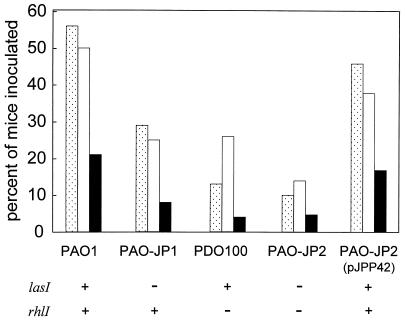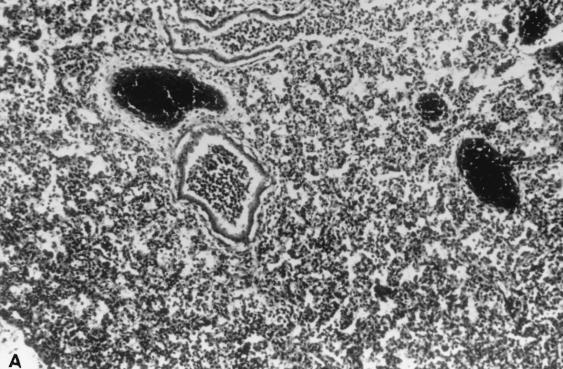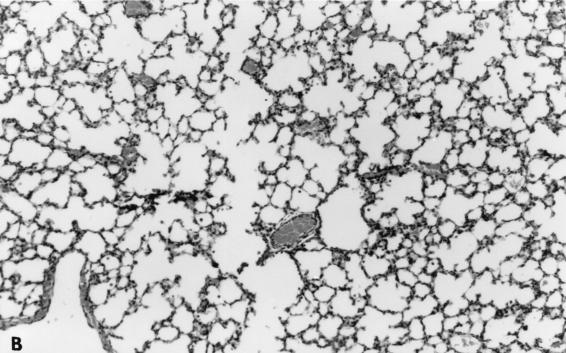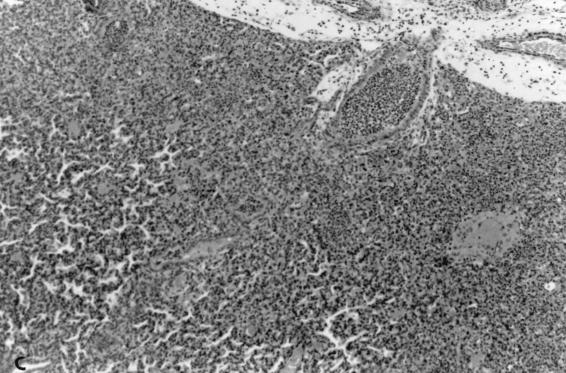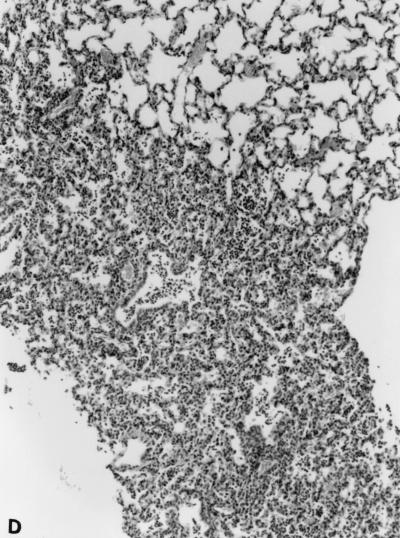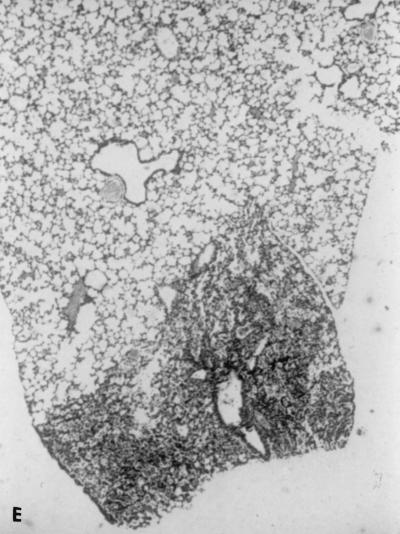Abstract
Cell-to-cell signaling controls many virulence genes in Pseudomonas aeruginosa. We tested the virulence of las and rhl quorum-sensing mutants in neonatal mice. A lasI rhlI double mutant was nearly avirulent, and the respective single mutant strains were reduced in virulence compared with the wild-type strain. Quorum sensing plays a role in P. aeruginosa pneumonia in neonatal mice.
Pseudomonas aeruginosa frequently causes pneumonia (3, 6), septicemia (7), and other acute infections (25) in immunocompromised patients (for review see reference 2). This gram-negative bacterium also causes chronic lung infections in cystic fibrosis patients (11). Virulence of P. aeruginosa depends on both cellular and extracellular factors. Cell-associated pili, flagella, and lipopolysaccharide are important surface components of P. aeruginosa which facilitate attachment of the organism to host cell surfaces and activate immune responses. These cellular bacterial constituents are required for virulence in a number of models of P. aeruginosa infection (5, 8, 13, 24, 30, 31). Extracellular or secreted virulence factors, such as proteases (elastase and alkaline protease) and toxins (exotoxin A and the exoenzymes S, T, and U), have also been shown to be necessary for virulence in animal models of P. aeruginosa infection (1, 12, 13, 15, 28).
P. aeruginosa controls the expression of many of its extracellular virulence factors by quorum-sensing systems (reviewed in reference 9). Most quorum-sensing signals are acyl homoserine lactones (AHL), which diffuse in and out of gram-negative bacterial cells (14, 22). When a threshold AHL concentration is reached, the AHL binds a LuxR-type transcriptional activator that induces expression of certain genes. For P. aeruginosa two such systems have been described. The las system consists of lasI and lasR (encoding an AHL synthase and a transcriptional activator, respectively) (10, 18) and the AHL signal N-3-oxo-dodecanoyl homoserine lactone (19). A second P. aeruginosa quorum-sensing system (rhl) consists of rhlI and rhlR (encoding an AHL synthase and a transcriptional activator, respectively) (16, 17) and the AHL signal N-butyryl homoserine lactone (20, 33). These two P. aeruginosa quorum-sensing systems regulate expression of extracellular virulence factors (reviewed in reference 23).
The role of quorum sensing in P. aeruginosa virulence has only begun to be studied, although there is already great interest in using this system as a target for novel forms of antibacterial chemotherapy. A P. aeruginosa lasR mutant was avirulent in a neonatal mouse model of acute pulmonary infection (31). In models of systemic infection of both Caenorhabditis elegans and mice, a lasR mutant has been found to be significantly attenuated in its virulence (4, 29). Here we further examined quorum sensing in P. aeruginosa mutants which lack the AHL synthase genes lasI and rhlI (Table 1). Quantitative assays of elastase and rhamnolipid production demonstrated that these P. aeruginosa mutant strains were fully complemented when the respective lasI or rhlI gene (or both) was added back on a plasmid (21). We used a previously described neonatal mouse model of pulmonary infection to assay for P. aeruginosa virulence (30). Briefly, entire litters of 7- to 10-day-old strain BALB/cByJ mice (Jackson Labs) were intranasally inoculated with 1.5 × 109 CFU of P. aeruginosa per mouse (30). Inocula were prepared from 14- to 17-h cultures grown at 37°C with shaking in M9 medium (27) containing 0.2% glucose and 1 mM MgSO4. Mice were returned to the mother for 24 h and then sacrificed. Lung and spleen tissue was prepared for bacteriology (enumeration of CFU per tissue homogenate by plate counts on MacConkey-lactose agar [Difco Corp., Detroit, Mich.]) and histopathology as described previously (30). Pneumonia was defined by two criteria: (i) the presence of >103 CFU of P. aeruginosa per lung homogenate and (ii) histopathological evidence of destruction of the lung parenchyma, edema, and leukocyte infiltration. Bacteremia was defined as the presence of at least one CFU of P. aeruginosa per spleen (30).
TABLE 1.
P. aeruginosa strains used in this study
When mice were inoculated with the P. aeruginosa lasI rhlI double mutant (strain PAO-JP2) (n = 21), only 1 mouse died, and 2 mice had >103 CFU per lung (Fig. 1). In contrast, 19 of the 34 animals inoculated with the wild-type strain, PAO1, developed confluent pneumonia throughout the lungs, and mortality occurred in 21% of the inoculated animals. Bacteremia was also reduced in mice infected with the quorum-sensing double mutant compared to that in mice infected with the wild type. Sections of lung tissue from an animal with >103 CFU per lung of the lasI rhlI strain, PAO-JP2, showed only a mild focal pneumonia (Fig. 2). The lung tissue of mice infected with the parental wild-type P. aeruginosa strain, PAO1, showed a much more severe confluent pneumonia. The quorum-sensing double mutant strain, PAO-JP2, caused significantly less pneumonia (P < 0.001), bacteremia (P < 0.01), and mortality (P < 0.05) than the wild-type strain as calculated using a Z test of proportions. To determine the relative contributions to virulence of the two quorum-sensing systems, the lasI and rhlI single mutant strains (PAO-JP1 and PDO100, respectively) were tested. These strains were both less virulent than the parental strain (Fig. 1). Strain PAO-JP1 (lasI) caused significantly less pneumonia and bacteremia (P < 0.05 for each) than strain PAO1. Significantly fewer mice developed pneumonia (P < 0.001) or bacteremia (P < 0.05) or died (P < 0.05) when inoculated with strain PDO100 (rhlI) than when inoculated with strain PAO1. While the lasI mutant caused pneumonia in approximately 30% of the animals, the rhlI mutant was associated with pneumonia in only 15%, although both single mutants caused bacteremia in 25% of the mice. These differences in the host response to strains PAO-JP1 and PDO100 may indicate that rhlI is required for the expression of certain gene products which specifically stimulate airway inflammation and result in pneumonia. The results suggest that both the las and rhl quorum-sensing systems are important for virulence of P. aeruginosa in the neonatal mouse model.
FIG. 1.
Contribution of P. aeruginosa AHL synthase genes lasI and rhl in the pathogenesis of pneumonia, bacteremia, and mortality in neonatal mice. The percentage of the total number of mice that developed pneumonia (dotted bars), bacteremia (white bars), or died (black bars) by 18 h following intranasal inoculation with the P. aeruginosa strains indicated is shown: PAO1, n = 34; PAO-JP1 n = 24; PDO100, n = 23; PAO-JP2, n = 21; and PAO-JP2(pJPP42), n = 21. P values are indicated in the text.
FIG. 2.
Histopathology associated with infection due to P. aeruginosa strains. Shown are hemotoxylin-and-eosin-stained sections of murine lung 18 h following inoculation with P. aeruginosa. (A) PAO1-infected lung showing widespread pneumonia, with consolidation and polymorphonuclear leukocytes visible in small bronchi; (B) normal uninfected control lung; (C) PAO1-JP2(pJPP42)-infected lung showing severe pneumonia; (D) PAO-JP1-infected lung showing focal pneumonia, with several regions of normal airspaces visible; (E) PAO-JP2-infected lung showing focal pneumonia present peripherally and large areas of normal tissue. Magnifications, ×100 (A to D) and ×50 (E).
To confirm that virulence can be restored by complementation of the P. aeruginosa lasI rhlI double mutant with functional lasI and rhlI genes, mice were inoculated with strain PAO-JP2 transformed with pJPP42 expressing rhlI and lasI described previously (21). Fifty percent of the animals inoculated with strain PAO-JP2(pJPP42) developed pneumonia and 38% developed bacteremia. These findings were similar to results obtained with the parent strain, where pneumonia and bacteremia occurred in 56 and 50% of the animals, respectively. These results indicated that the low level of virulence associated with the mutant strain PAO-JP2 was due to the lack of functional lasI and rhlI genes, as complementation of the wild-type genes restored virulence to nearly wild-type levels.
The effects of the lasI and rhlI mutations on P. aeruginosa virulence are consistent with the effects of these mutations on P. aeruginosa production of the virulence factors elastase and rhamnolipid (21). The focal nature of the pneumonia stimulated by strain PAO-JP2 suggests that elastase and possibly rhamnolipid expression are important in allowing the dissemination of infection and invasion of organisms into the bloodstream. Even early in the establishment of pulmonary infection, as demonstrated in this model of pulmonary disease, it appears that AHL-dependent coordination of bacterial gene expression is important in pathogenesis.
Rumbaugh et al. have recently tested the strain PAO1 lasI and rhlI mutants in a mouse burn model of P. aeruginosa infection and showed that these mutants were significantly less virulent than the wild-type strain (26). Thus, in two independent studies using different models of infection, mutations in quorum-sensing genes resulted in decreased virulence. A recent report has shown that at least 39 genes are controlled by quorum sensing in P. aeruginosa (32). Many of these genes have unknown functions, or the corresponding null mutant strains have not yet been tested in animal models for virulence. Our results indicate that functional quorum-sensing systems are important for the development of P. aeruginosa acute pneumonia. Further work will be needed to pinpoint which quorum-sensing-controlled virulence factors are essential for P. aeruginosa virulence in the neonatal mouse model of pneumonia.
Acknowledgments
This research was supported by NIH grant A133713 (B.H.I.), NIH predoctoral training grant 5-T32 AI07362 (J.P.P.), and grant DK39693 (A.P.).
REFERENCES
- 1.Blackwood L L, Stone R M, Iglewski B H, Pennington J E. Evaluation of Pseudomonas aeruginosa exotoxin A and elastase as virulence factors in acute lung infection. Infect Immun. 1983;39:198–201. doi: 10.1128/iai.39.1.198-201.1983. [DOI] [PMC free article] [PubMed] [Google Scholar]
- 2.Bodey G P, Bolivar R, Fainstein V, Jadeja L. Infections caused by Pseudomonas aeruginosa. Rev Infect Dis. 1993;5:270–313. doi: 10.1093/clinids/5.2.279. [DOI] [PubMed] [Google Scholar]
- 3.Brewer S C, Wunderink R G, Jones C B, Leeper K V J. Ventilator-associated pneumonia due to Pseudomonas aeruginosa. Chest. 1996;109:1019–1029. doi: 10.1378/chest.109.4.1019. [DOI] [PubMed] [Google Scholar]
- 4.Brint J M, Ohman D E. Synthesis of multiple exoproducts in Pseudomonas aeruginosa is under the control of RhlR-RhlI, another set of regulators in strain PAO1 with homology to the autoinducer-responsive LuxR-LuxI family. J Bacteriol. 1995;177:7155–7163. doi: 10.1128/jb.177.24.7155-7163.1995. [DOI] [PMC free article] [PubMed] [Google Scholar]
- 5.Cryz S J, Jr, Fürer E, Germanier R. Protection against Pseudomonas aeruginosa infection in a murine burn wound sepsis model by passive transfer of antitoxin A, antielastase, and antilipopolysaccharide. Infect Immun. 1983;39:1072–1079. doi: 10.1128/iai.39.3.1072-1079.1983. [DOI] [PMC free article] [PubMed] [Google Scholar]
- 6.Dunn M, Wunderink R G. Ventilator-associated pneumonia caused by Pseudomonas infection. Clin Chest Med. 1995;16:95–109. [PubMed] [Google Scholar]
- 7.Edmond M B, Wallace S E, McClish D K, Pfaller M A, Jones R N, Wenzel R P. Nosocomial bloodstream infections in United States hospitals: a three-year analysis. Clin Infect Dis. 1999;29:239–244. doi: 10.1086/520192. [DOI] [PubMed] [Google Scholar]
- 8.Feldman M, Bryan R, Rajan S, Scheffler L, Brunnert S, Tang H, Prince A. Role of flagella in pathogenesis of Pseudomonas aeruginosa pulmonary infection. Infect Immun. 1998;66:43–51. doi: 10.1128/iai.66.1.43-51.1998. [DOI] [PMC free article] [PubMed] [Google Scholar]
- 9.Fuqua W C, Winans S C, Greenberg E P. Census and consensus in bacterial ecosystems: the LuxR-LuxI family of quorum-sensing transcriptional regulators. Annu Rev Microbiol. 1996;50:727–751. doi: 10.1146/annurev.micro.50.1.727. [DOI] [PubMed] [Google Scholar]
- 10.Gambello M J, Iglewski B H. Cloning and characterization of the Pseudomonas aeruginosa lasR gene, a transcriptional activator of elastase expression. J Bacteriol. 1991;173:3000–3009. doi: 10.1128/jb.173.9.3000-3009.1991. [DOI] [PMC free article] [PubMed] [Google Scholar]
- 11.Govan J R W, Deretic V. Microbial pathogenesis in cystic fibrosis: mucoid Pseudomonas aeruginosa and Burkholderia cepacia. Microbiol Rev. 1996;60:539–574. doi: 10.1128/mr.60.3.539-574.1996. [DOI] [PMC free article] [PubMed] [Google Scholar]
- 12.Hauser A R, Kang P J, Engel J N. PepA, a secreted protein of Pseudomonas aeruginosa, is necessary for cytotoxicity and virulence. Mol Microbiol. 1998;27:807–818. doi: 10.1046/j.1365-2958.1998.00727.x. [DOI] [PubMed] [Google Scholar]
- 13.Holder I A. The pathogenesis of infections owing to Pseudomonas aeruginosa using the burned mouse model: experimental studies from the Shriners Burns Institute, Cincinnati. Can J Microbiol. 1985;31:393–402. doi: 10.1139/m85-075. [DOI] [PubMed] [Google Scholar]
- 14.Kaplan H B, Greenberg E P. Diffusion of autoinducer is involved in regulation of the Vibrio fischeri luminescence system. J Bacteriol. 1985;163:1210–1214. doi: 10.1128/jb.163.3.1210-1214.1985. [DOI] [PMC free article] [PubMed] [Google Scholar]
- 15.Nicas T I, Iglewski B H. The contribution of exoproducts to virulence of Pseudomonas aeruginosa. Can J Microbiol. 1985;31:387–392. doi: 10.1139/m85-074. [DOI] [PubMed] [Google Scholar]
- 16.Ochsner U A, Koch A K, Fiechter A, Reiser J. Isolation and characterization of a regulatory gene affecting rhamnolipid biosurfactant synthesis in Pseudomonas aeruginosa. J Bacteriol. 1994;176:2044–2054. doi: 10.1128/jb.176.7.2044-2054.1994. [DOI] [PMC free article] [PubMed] [Google Scholar]
- 17.Ochsner U A, Reiser J. Autoinducer-mediated regulation of rhamnolipid biosurfactant synthesis in Pseudomonas aeruginosa. Proc Natl Acad Sci USA. 1995;92:6424–6428. doi: 10.1073/pnas.92.14.6424. [DOI] [PMC free article] [PubMed] [Google Scholar]
- 18.Passador L, Cook J M, Gambello M J, Rust L, Iglewski B H. Expression of Pseudomonas aeruginosa virulence genes requires cell-to-cell communication. Science. 1993;260:1127–1130. doi: 10.1126/science.8493556. [DOI] [PubMed] [Google Scholar]
- 19.Pearson J P, Gray K M, Passador L, Tucker K D, Eberhard A, Iglewski B H, Greenberg E P. Structure of the autoinducer required for expression of Pseudomonas aeruginosa virulence genes. Proc Natl Acad Sci USA. 1994;91:197–201. doi: 10.1073/pnas.91.1.197. [DOI] [PMC free article] [PubMed] [Google Scholar]
- 20.Pearson J P, Passador L, Iglewski B H, Greenberg E P. A second N-acylhomoserine lactone signal produced by Pseudomonas aeruginosa. Proc Natl Acad Sci USA. 1995;92:1490–1494. doi: 10.1073/pnas.92.5.1490. [DOI] [PMC free article] [PubMed] [Google Scholar]
- 21.Pearson J P, Pesci E C, Iglewski B H. Roles of Pseudomonas aeruginosa las and rhl quorum-sensing systems in control of elastase and rhamnolipid biosynthesis genes. J Bacteriol. 1997;179:5756–5767. doi: 10.1128/jb.179.18.5756-5767.1997. [DOI] [PMC free article] [PubMed] [Google Scholar]
- 22.Pearson J P, Van Delden C, Iglewski B H. Active efflux and diffusion are involved in transport of Pseudomonas aeruginosa cell-to-cell signals. J Bacteriol. 1999;181:1203–1210. doi: 10.1128/jb.181.4.1203-1210.1999. [DOI] [PMC free article] [PubMed] [Google Scholar]
- 23.Pesci E C, Iglewski B H. The chain of command in Pseudomonas quorum sensing. Trends Microbiol. 1997;5:132–134. doi: 10.1016/S0966-842X(97)01008-1. [DOI] [PubMed] [Google Scholar]
- 24.Pier G B, Meluleni G, Neuger E. A murine model of chronic mucosal colonization by Pseudomonas aeruginosa. Infect Immun. 1992;60:4768–4776. doi: 10.1128/iai.60.11.4768-4776.1992. [DOI] [PMC free article] [PubMed] [Google Scholar]
- 25.Rolston K V I, Tarrand J J. Pseudomonas aeruginosa—still a frequent pathogen in patients with cancer: 11-year experience at a comprehensive cancer center. Clin Infect Dis. 1999;29:463–464. doi: 10.1086/520247. [DOI] [PubMed] [Google Scholar]
- 26.Rumbaugh K P, Griswold J A, Iglewski B H, Hamood A N. Contribution of quorum sensing to the virulence of Pseudomonas aeruginosa in burn wound infections. Infect Immun. 1999;67:5854–5862. doi: 10.1128/iai.67.11.5854-5862.1999. [DOI] [PMC free article] [PubMed] [Google Scholar]
- 27.Sambrook J, Fritsch E F, Maniatis T. Molecular cloning: a laboratory manual. 2nd ed. Cold Spring Harbor, N.Y: Cold Spring Harbor Laboratory; 1989. [Google Scholar]
- 28.Sawa T, Ohara M, Kurahashi K, Twining S S, Frank D W, Doroques D B, Long T, Gropper M A, Wiener-Kronish J P. In vitro cellular toxicity predicts Pseudomonas aeruginosa virulence in lung infections. Infect Immun. 1998;66:3242–3249. doi: 10.1128/iai.66.7.3242-3249.1998. [DOI] [PMC free article] [PubMed] [Google Scholar]
- 29.Tan M W, Rahme L G, Sternberg J A, Tompkins R G, Ausubel F M. Pseudomonas aeruginosa killing of Caenorhabditis elegans used to identify P. aeruginosa virulence factors. Proc Natl Acad Sci USA. 1999;96:2408–2413. doi: 10.1073/pnas.96.5.2408. [DOI] [PMC free article] [PubMed] [Google Scholar]
- 30.Tang H, Kays M, Prince A. Role of Pseudomonas aeruginosa pili in acute pulmonary infection. Infect Immun. 1995;63:1278–1285. doi: 10.1128/iai.63.4.1278-1285.1995. [DOI] [PMC free article] [PubMed] [Google Scholar]
- 31.Tang H B, DiMango E, Bryan R, Gambello M, Iglewski B H, Goldberg J B, Prince A. Contribution of specific Pseudomonas aeruginosa virulence factors to pathogenesis of pneumonia in a neonatal mouse model of infection. Infect Immun. 1996;64:37–43. doi: 10.1128/iai.64.1.37-43.1996. [DOI] [PMC free article] [PubMed] [Google Scholar]
- 32.Whiteley M, Lee K M, Greenberg E P. Identification of genes controlled by quorum sensing in Pseudomonas aeruginosa. Proc Natl Acad Sci USA. 1999;96:13904–13909. doi: 10.1073/pnas.96.24.13904. [DOI] [PMC free article] [PubMed] [Google Scholar]
- 33.Winson M K, Camara M, Latifi A, Foglino M, Chhabra S R, Daykin M, Bally M, Chapon V, Salmond G P, Bycroft B W, et al. Multiple N-acyl-l-homoserine lactone signal molecules regulate production of virulence determinants and secondary metabolites in Pseudomonas aeruginosa. Proc Natl Acad Sci USA. 1995;92:9427–9431. doi: 10.1073/pnas.92.20.9427. [DOI] [PMC free article] [PubMed] [Google Scholar]



